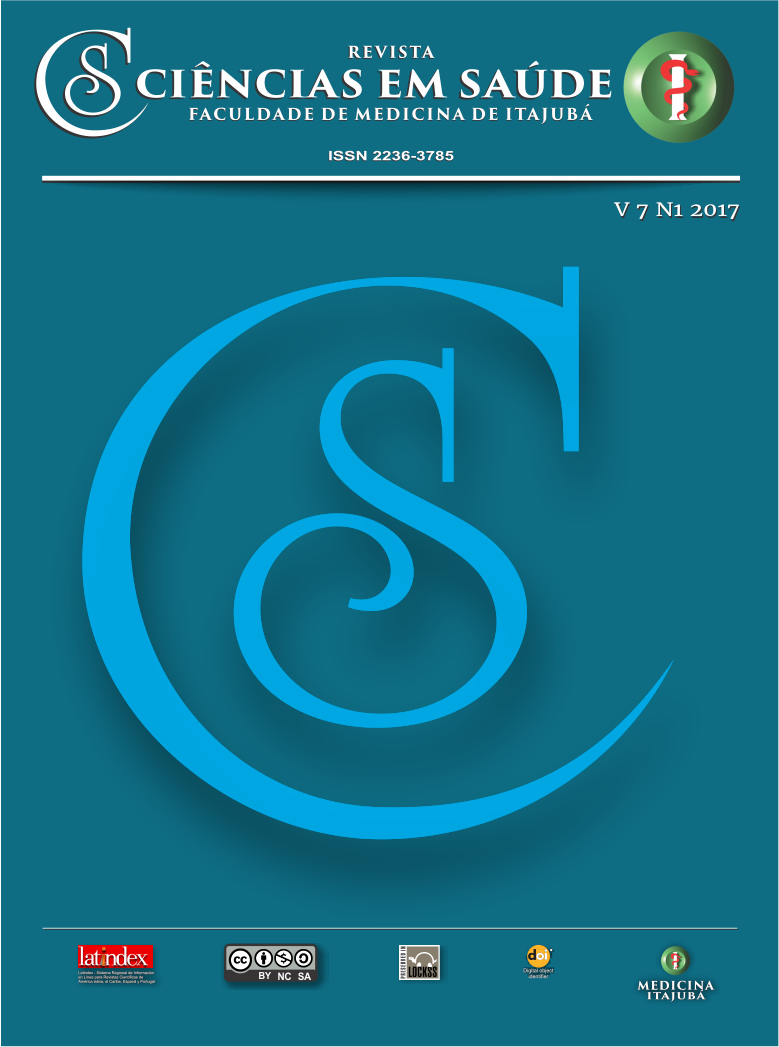Análise da resistência às quinolonas e sulfametoxazol-trimetoprim em uroculturas positivas para Escherichia coli em infecções do trato urinário comunitárias no período de 2010 a 2014 em Itajubá – MG / Analysis of quinolones and trimethoprim-sulfamethoxazole resistance in positive Escherichia coli urucultures in urinary tract infections in a community environment from 2010 to 2014 in Itajubá – MG
Main Article Content
Abstract
Introdução: As infecções do trato urinário (ITU), de origem comunitária, são diagnósticos muito prevalentes a nível ambulatorial, sendo uma grande causa de uso de antibioticoterapia. Seus agentes etiológicos mais prevalentes são os bacilos gram-negativos da família Enterobacteriaceae, em especial a Escherichia coli (E. coli). Visando este agente, as terapias antimicrobianas empíricas mais utilizadas no Brasil são o sulfametoxazol-trimetoprim, quinolonas, cefalosporinas de 1º e 2º geração, amoxicilina e nitrofurantoína. Objetivos: Tendo em vista o aumento da antibioticorresistência a estes medicamentos, demonstrado na literatura médica mundial, e a importância do conhecimento deste dado pela comunidade médica local, este artigo pretende traçar o perfil de resistência às quinolonas e ao sulfametoxazol-trimetoprim pelas cepas de E. coli isoladas de uroculturas de ITU comunitária, encaminhadas para um laboratório de análises clínicas, de uma cidade do sul de Minas Gerais, no período de 2010 a 2014. Métodos: Estudo descritivo e retrospectivo por meio de pesquisa em banco de dados, no período de 2010 a 2014. Foram realizadas análises de urocultura e antibiograma, com cálculo estatístico utilizando-se o teste qui-quadrado. Resultados: Foram obtidas 14870 uroculturas, tendo crescimento bacteriano maior que 105 unidades formadoras de colônia (UFC) em 3073 amostras, das quais 2203 foram cepas de E. coli e 870 de outras bactérias. A taxa global de resistência nos 5 anos de todos os antibióticos foi de 24,46%, sendo que a de sulfametoxazol-trimetoprim em específico foi de 19,65% e a do grupo quinolonas, 19,2%. Observou-se aumento da resistência ao longo dos 5 anos (p<0,0001) e que é mais incidente em mulheres e em maiores de 65 anos. Conclusão: As taxas de resistência às quinolonas e ao sulfametoxazol-trimetoprim atingiram níveis próximos do limiar permitido para seu uso empírico. A idade e o gênero mostram-se fatores importantes na antibioticorresistência, especialmente nos maiores de 65 anos e no gênero feminino.
Palavras-chave: Infecções urinárias; Farmacorresistência bacteriana; Infecções comunitárias adquiridas; Quinolonas; Trimetropima-sulfametoxazol
ABSTRACT
Introduction: Communitarian urinary tract infections are frequently diagnosed ambulatorily, and they are the most important cause for using antibiotic therapy. Its most common agents are gram-negative bacils from the enterobacteriaceae family, especially Escherichia coli (E. coli). Focusing on this bacterium, the empiric antibiotic therapies which are mostly used in Brazil are trimethoprim/sulfamethoxazole, quinolones, 1st and 2nd generation of cephalosporin, amoxicillin, and nitrofurantoin. Aims: Foreseeing the intense growth of antibiotic therapy resistance to these drugs shown in the world's medical literature and the importance of local medical community having knowledge of this data, this article proposes the research of quinolones and trimethoprim-sulfamethoxazole combination resistance to E. coli bacteria isolated in community-acquired UTI urocultures, from a clinical analysis laboratory, in the period from 2010 to 2014 in a southern city of the state of Minas Gerais. Methods: Retrospective and descriptive study by database research in the period from 2010 to 2014. Urocultures and antibiogram analysis were done, and the statistic calculous were made by using qui-square's test. Results: 14870 urocultures were studied. However, only 3073 samples had significant bacterial growth (bigger than 105CFU). From this result, 2203 were E. coli samples and 870 were from other bacteria. The global resistance in this 5 year study for all antibiotics was 24,46 %. Furthermore, trimethoprim-sulfamethoxazole combination resistance was 19,65% and the quinolones group was 19,2%. Through research, we have noticed an increasing resistance through these five years (p<0,0001), thus, having bigger incidence in woman and in people older than 65 years old. Conclusion: Antibiotic resistance rates almost reach unacceptable levels for therapeutic use. Age and gender demonstrated importance at antibiotic resistance, especially for people older than 65 years of age and the feminine gender.
Keywords: Urinary tract infections; Drug resistance bacterial; Community-acquired infections; Quinolones; Trimethoprim-sulfamethoxazole
Article Details
Authors maintain copyright and grant the HSJ the right to first publication. From 2024, the publications wiil be licensed under Attribution 4.0 International 
 , allowing their sharing, recognizing the authorship and initial publication in this journal.
, allowing their sharing, recognizing the authorship and initial publication in this journal.
Authors are authorized to assume additional contracts separately for the non-exclusive distribution of the version of the work published in this journal (e.g., publishing in an institutional repository or as a book chapter), with acknowledgment of authorship and initial publication in this journal.
Authors are encouraged to publish and distribute their work online (e.g., in institutional repositories or on their personal page) at any point after the editorial process.
Also, the AUTHOR is informed and consents that the HSJ can incorporate his article into existing or future scientific databases and indexers, under the conditions defined by the latter at all times, which will involve, at least, the possibility that the holders of these databases can perform the following actions on the article.
